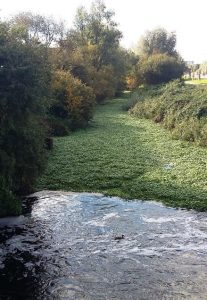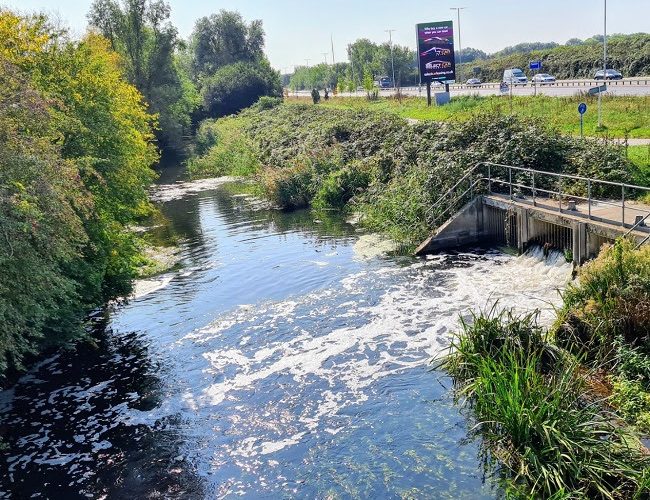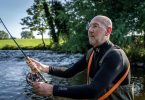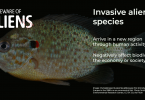Environment groups, government agencies and the Angling Trust are joining forces to help halt the spread of a highly invasive non-native plant that is choking rivers and lakes across Great Britain.
 Tiny fragments of floating pennywort can grow at an incredible 20cms a day, rapidly forming dense rafts on the water’s surface that block out light, stifle native plants, and make the rivers and lakes less suitable for insects, fish and other wildlife.
Tiny fragments of floating pennywort can grow at an incredible 20cms a day, rapidly forming dense rafts on the water’s surface that block out light, stifle native plants, and make the rivers and lakes less suitable for insects, fish and other wildlife.
The dense rafts can also make waters inaccessible to anglers, boaters, and other water users and can present significant flood risks, creating plant dams which can back up around weirs and clog up sluices and drains.
Floating pennywort is notoriously difficult to control because very small fragments of the plant can regrow meaning that efforts to eradicate it need to be regular and focussed.
A new way of working
In recent years, local strategic partnerships and collaborative projects have begun to form. On the River Kennet and tributaries in Reading, Reading and District Angling Association (RDAA) have been working closely with the Environment Agency (EA), Green Park Business Park and Canal & River Trust (CRT) to remove floating pennywort.
Here, large rafts of floating pennywort have been removed and regular checks are undertaken to ensure that any remaining fragments are also tackled. A contractor carries this out for RDAA and Green Park, while the EA’s field team covers the downstream reach of the Kennet before it joins the River Thames.
Dave Willis, Environment Manager for the Environment Agency, said:
“The Environment Agency is excited to be working together with volunteers from a range of organisations who play a key role in the surveillance and management of floating pennywort. By working together we can reduce this highly invasive plant’s impact and improve the water environment for both wildlife and people.”
Del Shackleford, from Reading and District Angling Association, said:
“Working collectively is the only way to deal with any invasive species, particularly one such as pennywort. With the Environment Agency, as with all organisations of their type struggling to earmark funds and manpower, it’s up to collectives to orchestrate funding, planning and delivery in a holistic manner, if we stand any chance of eradicating the environmental nuisance that is pennywort.”
The future
Learning from the success of this project, and similar efforts in other catchments, plans are being developed to expand this approach nationwide. By working together, and establishing local partnerships, it is hoped the further spread of floating pennywort is prevented and its impacts in established catchments minimised.
Dr Emily Smith, Environment Manager at the Angling Trust, said:
“Effective management of floating pennywort can only be achieved through strategic, coordinated action. The partnership established on the River Kennet is a great example of how government organisations and community groups can work together to make a real difference to the environment.
“As a result of this success, and other similar examples across the country, the Angling Trust, British Canoeing, the Environment Agency and the Non-Native Species Secretariat are working together on a new national strategy to tackle floating pennywort. The strategy will be launched in spring 2021.”
Locally, volunteer efforts are continuing to expand, and a second local partnership is being developed with canoe clubs and angling clubs on the Thames at Reading this season. The Environmental Audit Committee (EAC) Invasive Species Inquiry called for a more strategic, catchment-based approach to invasive species management and the formation of a ‘citizen’s army’ to help to tackle invasive species and we hope that this partnership can be reviewed, refined and expanded to help meet the EAC recommendations.
Philip Dunne MP, the chair of the EAC inquiry, said:
“One year on from our Invasive Species report, it is great to see organisations and volunteers come together to tackle floating pennywort. Non-native pennywort not only threatens biodiversity, it clogs up drains and is a nuisance to water users. I was very pleased to see for myself how effective efforts to stop the spread of this highly invasive plant have been in cleaning up the River Kennet.
“We found in our inquiry that invasive non-native species are one of the top five threats to the natural environment and maintaining biodiversity. We can all have a role stopping invasive species in their tracks.”
How you can help
The partnership is encouraging people who visit the River Thames and its tributaries to support the project by familiarising themselves with what floating pennywort looks like and reporting any sightings of it to the Environment Agency by emailing enquiries_THM@environment-
If you are not sure if the plant you have seen is floating pennywort, please do still report it. With more support from local people the partnership will be in the best possible position to halt the spread of this invasive plant. Look out for shiny, kidney-shaped leaves (up to 7cm wide) with a crinkly edge, held on fleshy stalks that can be both floating and emergent. More information on identifying floating pennywort.
Pond and garden plants should never be dumped or allowed to escape into the wild, and gardeners are being encourage to ‘be plant wise’ and compost their plant material carefully.










